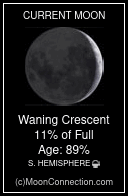| Caldera |
A type of volcanic crater that is extremely large, usually formed by the collapse of a volcanic cone or by a violent volcanic explosion. Crater Lake is one example of a caldera on Earth. |
| Catadioptric |
Relecting and refracting |
| Catena |
A series or chain of craters. |
| Catoptric |
Concerning reflections |
| Cavus |
A hollow, irregular depression. |
| Celestial Equator |
An imaginary line that divides the celestial sphere into a northern and southern hemisphere. |
| Celestial Pole |
Point in the sky directly above the Earth's poles. |
| Celestial Sphere |
An imaginary sphere around the Earth on which the stars and planets appear to be positioned. |
| Cepheid Variable |
This is a variable star whose light pulsates in a regular cycle. The period of fluctuation is linked to the brightness of the star. Brighter Cepheids will have a longer period. |
| Chaos |
A distinctive area of broken terrain. |
| Chasma |
Another name used to describe a canyon. |
| Chondrite |
A meteorite that contains chondrules. |
| Chondrule |
Small, glassy spheres commonly found in meteorites. |
| Chromosphere |
The part of the Sun's atmosphere just above the surface. |
| Circumpolar Star |
A star that never sets but always stays above the horizon. This depends on the location of the observer. The further South you go the fewer stars will be circumpolar. Polaris, the North Star, is circumpolar in most of the northern hemisphere. |
| Circumstellar Disk |
A torus or ring-shaped accumulation of gas, dust, or other debris in orbit around a star in different phases of its life cycle. |
| Coal Sack Nebula |
|
| Collimation |
the alignment of the optical elements in a telescope. |
| Coma |
An area of dust or gas surrounding the nucleus of a comet. |
| Comet |
A gigantic ball of ice and rock that orbit the Sun in a highly eccentric orbit. Some comets have an orbit that brings them close to the Sun where they form a long tail of gas and dust as they are heated by the Sun's rays. |
| Conjunction |
Alignment of two or more bodies (normally in line with the sun) |
| Constellation |
A pattern of stars identified by name. (88 official constellations) |
| Corona |
The outer part of the Sun's atmosphere. The corona is visible from Earth during a total solar eclipse. It is the bright glow seen in most solar eclipse photos. |
| Cosmic Ray |
Atomic nuclei (mostly protons) that are observed to strike the Earth's atmosphere with extremely high amounts of energy. |
| Cosmic String |
A tube-like configuration of energy that is believed to have existed in the early universe. A cosmic string would have a thickness smaller than a trillionth of an inch but its length would extend from one end of the visible universe to the other. |
| Cosmogony |
The study of celestial systems, including the Solar System, stars, galaxies, and galactic clusters. |
| Cosmology |
A branch of science that deals with studying the origin, structure, and nature of the universe. |
| Crater |
A bowl-shaped depression formed by the impact of an asteroid or meteoroid. Also the depression around the opening of a volcano. |

